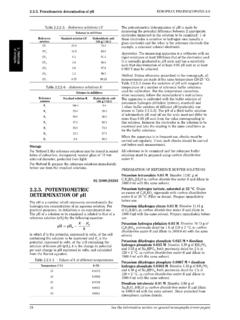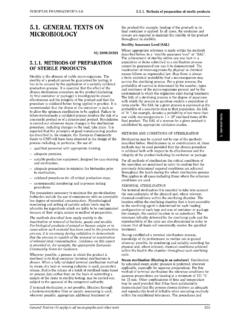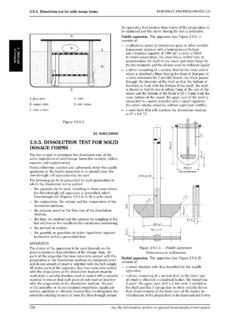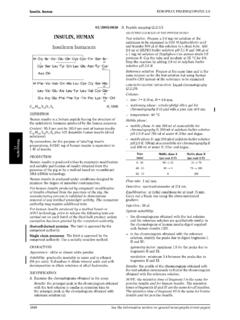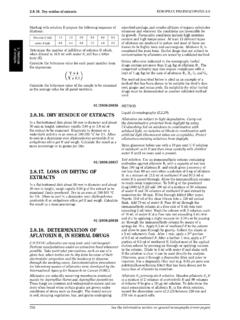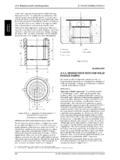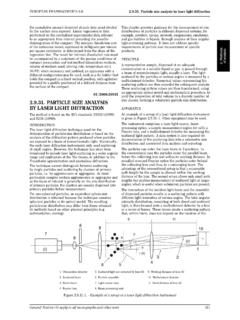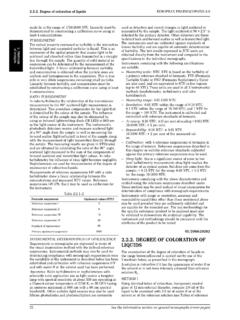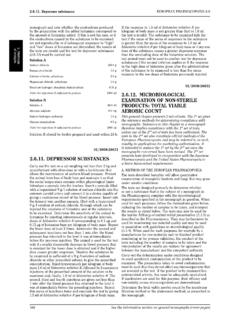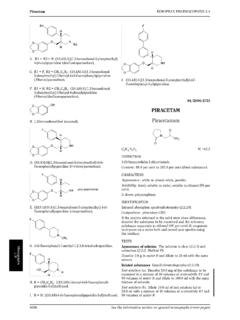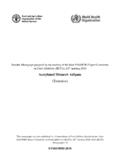Transcription of EUROPEAN PHARMACOPOEIA 5 - uspbpep.com
1 EUROPEAN PHARMACOPOEIA Relative densityTable pH of reference buffer solutions at various temperaturesTemperature( C) MPotassiumhydrogentartratesaturatedat 25 M+ M+ M+ MCalciumhydroxide,saturatedat 25 CC4H3KO8,2H2OC4H5KO6C6H7KO7C8H5KO4KH2PO4 +Na2 HPO4KH2PO4+Na2 HPO4Na2B4O7,10H2 ONa2CO3+NaHCO3Ca(OH) + + (1) pH variation per degree dihydrogen phosphate M + disodiumhydrogen phosphate M. Dissolve g of KH2PO4and g of Na2 HPO4, both previously dried for 2 h at120 2 C,incarbon dioxide-free water Rand dilute dihydrogen phosphate M + disodiumhydrogen phosphate M. Dissolve g of KH2PO4and g of Na2 HPO4, both previously dried for 2 h at120 2 C,incarbon dioxide-free water Rand dilute tetraborate M. Dissolve g ofNa2B4O7,10H2 Oincarbon dioxide-free water Rand diluteto ml with the same solvent.
2 Store protected fromatmospheric carbon carbonate M + sodium hydrogen M. Dissolve g of Na2CO3and g of NaHCO3incarbon dioxide-free water Rand dilute to ml withthe same solvent. Store protected from atmospheric hydroxide, saturated at 25 hydroxide Rwithcarbon dioxide-free water Randdecant at 25 C. Store protected from atmospheric buffer solutions in suitable chemically resistant, tightcontainers, such as type I glass bottles or plastic containerssuitable for aqueous RELATIONSHIP BETWEENREACTION OF SOLUTION,APPROXIMATE pH AND COLOUROF CERTAIN INDICATORSTo 10 ml of the solution to be examined, add ml ofthe indicator solution, unless otherwise prescribed inTable >8 Litmus paper red RBlueThymol bluesolution R( ml)Grey or violet-blueSlightly R( ml)Colourless or pinkThymol bluesolution R( ml)GreyStrongly alkaline>10 Phenolphthaleinpaper RRedThymol bluesolution R( ml) red solution RYellowPhenol redsolution R( ml)Neutral to red solution ROrange-redNeutral tophenolphtalein< R( ml)Colourless.
3 Pink or redafter adding mlof M baseAcid<6 Methyl red solution ROrange or redBromothymol bluesolution R1 YellowFaintly red solution ROrangeBromocresol greensolution RGreen or blueStrongly acid<4 Congo red paper RGreen or blue01/2005 RELATIVE DENSITYThe relative densityof a substance is the ratio of themass of a certain volume of a substance at temperaturet1tothe mass of an equal volume of water at otherwise indicated, the relative densityisused. Relative density is also commonly expressed 20, defined as the mass of a unit volume ofthe substance at 20 C may also be used, expressed inkilograms per cubic metre or grams per cubic centimetreGeneralNotices(1) Refractive indexEUROPEAN PHARMACOPOEIA (1 kg m 3=10 3g cm 3). These quantities are related by thefollowing equations where density is expressed in grams percubic centimetre:Relative density or density are measured with the precisionto the number of decimals prescribed in the monographusing a density bottle (solids or liquids), a hydrostaticbalance (solids), a hydrometer (liquids) or a digital densitymeter with an oscillating transducer (liquids and gases).
4 When the determination is made by weighing, the buoyancyof air is disregarded, which may introduce an error of 1 unitin the 3rddecimal place. When using a density meter, thebuoyancy of air has no transducer density of: a U-shaped tube, usually of borosilicate glass, whichcontains the liquid to be examined; a magneto-electrical or piezo-electrical excitation systemthat causes the tube to oscillate as a cantilever oscillatorat a characteristic frequency depending on the density oftheliquidtobeexamined; a means of measuring the oscillation period (T), whichmay be converted by the apparatus to give a directreading of density, or used to calculate density using theconstantsAandBdescribed resonant frequency (f)isafunctionofthespringconstant (c)andthemass(m) of the system:Hence:M=mass of the tube,V=inner volume of the of 2 constantsand, leads to the classical equation for the oscillatingtransducer:The constantsAandBare determined by operating theinstrument with the U-tube filled with 2 different samplesof known density, for example, degassedwater Rand measurements aremade daily using degassedwater R.
5 The results displayed for the control measurementusing degassedwater Rshall not deviate from the referencevalue ( 20= g cm 3,= ) by more thanits specified error. For example, an instrument specifiedto g cm 3shall display g cm 3inorder to be suitable for further measurement. Otherwisea re-adjustment is necessary. Calibration with certifiedreference materials is carried out regularly. to be examined is equilibrated in a thermostat at 20 Cbefore introduction into the tube, if necessary, to avoid theformation of bubbles and to reduce the time required affecting accuracy include: temperature uniformity throughout the tube, non-linearity over a range of density, parasitic resonant effects, viscosity, whereby solutions with a higher viscosity thanthe calibrant have a density that is apparently higher thanthe true effects of non-linearity and viscosity may be avoided byusing calibrants that have density and viscosity close to thoseoftheliquidtobeexamined( 5percentfordensity, 50percent for viscosity).
6 The density meter may have functions forautomatic viscosity correction and for correction of errorsarising from temperature changes and is a function of the repeatability and stability of theoscillator frequency, which is dependent on the stability ofthe volume, mass and spring constant of the meters are able to achieve measurements with anerroroftheorderof1 10 3g cm 3to 1 10 5g cm 3and arepeatability of 1 10 4g cm 3to 1 10 6g cm REFRACTIVE INDEXThe refractive index of a medium with reference to air isequal to the ratio of the sine of the angle of incidence of abeam of light in air to the sine of the angle of refraction ofthe refracted beam in the given otherwise prescribed, the refractive index is measuredat 20 C, with reference to the wavelength of the D-lineof sodium ( = ); normally determine the critical angle.
7 Insuch apparatus the essential part is a prism of knownrefractive index in contact with the liquid to be the apparatus using certified reference white light is used, the refractometer is providedwith a compensating system. The apparatus gives readingsaccurate to at least the third decimal place and is providedwith a means of operation at the temperature thermometer is graduated at intervals of C or OPTICAL ROTATIONO ptical rotation is the property displayed by chiral substancesof rotating the plane of polarisation of polarised rotation is considered to be positive (+) fordextrorotatory substances ( those that rotate the planeof polarisation in a clockwise direction) and negative ( )forlaevorotatory specific optical rotationis the rotation, expressedin radians (rad)
8 , measured at the temperaturetand atthe wavelength given by a 1 m thickness of liquid or asolution containing 1 kg/m3of optically active practical reasons the specific optical rotationis normally expressed in milliradians metre squared perkilogram (mrad m2 kg 1).The PHARMACOPOEIA adopts the following of optical rotationof a neat liquid is the angleof rotation ,expressedindegrees( ),oftheplaneofpolarisation at the wavelength of the D-line of sodium( = )measuredat20 Cusingalayerof1dm;for a solution, the method of preparation is prescribed inthe the information section on general monographs (cover pages)
